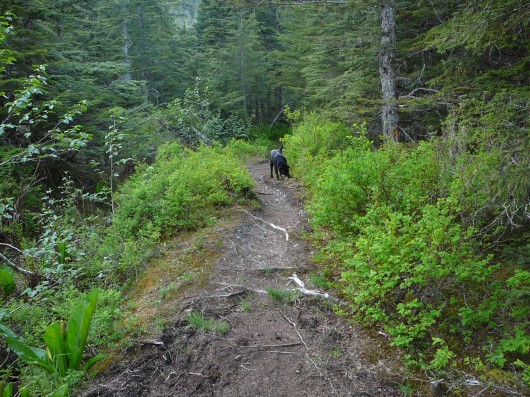
A dog explores part of the Tongass National Forest’s Treadwell Ditch Trail on Douglas Island, part of Juneau. (Ed Schoenfeld/CoastAlaska News)
The Forest Service is setting up an advisory board to help rewrite the Tongass National Forest’s management plan. It’s somewhat similar to another panel that shut down last year without completing its work.
Tongass managers have a couple big jobs ahead of them.
They’re reviewing and updating the land-management plan for the 17-million-acre forest. They’re also working on a roadmap for a transition from old-growth to young-growth timber harvests.
So, the agency has decided to recruit 15 people for an advisory committee.
Tongass Supervisor Forrest Cole says they’ll take about a year developing proposals for the U.S. Secretary of Agriculture and the chief of the Forest Service.
“What we’re really trying to do is find folks who have experience working in collaborative groups, knowledge regarding Southeast Alaska issues and willingness to work closely together (and) come up with a solution,” Cole says.
They’ll include representatives of the industry, state and federal agencies, environmental groups and tribal organizations.
That sounds a lot like the Tongass Futures Roundtable, a larger group with a somewhat similar mission. It began around seven years ago and shut down last spring after some timber and environmental groups quit.
Cole says it broke ground that should ease the way for the advisory panel.
“We had never had all of the interests in Southeast Alaska sit down in the same year together. So it was a fairly lengthy process, probably three of the six years it was around, it took to get people to physically be able to sit in a room, have a conversation and listen to diverse opinions,” Cole says.
“Collaboration is the watchword,” says former Juneau Mayor Bruce Botelho, who moderated the group and tried to keep it moving forward.
“Even though the roundtable did not perhaps achieve a lot of what it had initially set out to do, it created I think a climate of discussion between parties who needed to be talking to each other but historically did not,” he says.
Roundtable organizers hoped to develop a comprise to ongoing Tongass timber battles. But Cole says it did more than meet.
“There was a bridge timber proposal that was put together by Tongass Futures that got us out of a number of heavily-litigated projects and provided timber along the way to keep the current industry alive,” he says.
The Southeast Conference, a regional development organization, was part of the roundtable. But it joined the exodus of timber and state government representatives that led to its dissolution.
The conference last year proposed its own Tongass management plan. Leaders hope to advance that as part of the advisory group’s discussions.
“I’m excited about it. I guess I should say I’m ready for another round, because you just can’t stop trying,” says Shelly Wright, conference executive director.
She says the new panel has a better chance of succeeding.
“The roundtable really was not (an) official advisory group, so I think it may be a little bit different. The undersecretary has actually said this is for his information, so I think that’s going to give it a little more weight, so to speak,” she says.
Those interested in joining the Tongass Advisory Committee need to apply by February 27th. Details are here.
Cole says the Forest Service will chose members using its own standards.
“They’ll work among themselves to see if they can come up with a consensus-based recommendation that the Forest Service will take under advisement to further along the transition or the forest-plan modification,” he says.
But he doesn’t expect to make absolutely everybody involved in these issues happy.
“In fact there’s a number of federal advisory committees that have been established that never came to fruition. So there’s still a possibility that we can’t get a recommendation out of this group. And if not, we’ll proceed on.
He says the panel’s work will not delay the review of the land-management plan. That’s expected to be completed in 2016.





